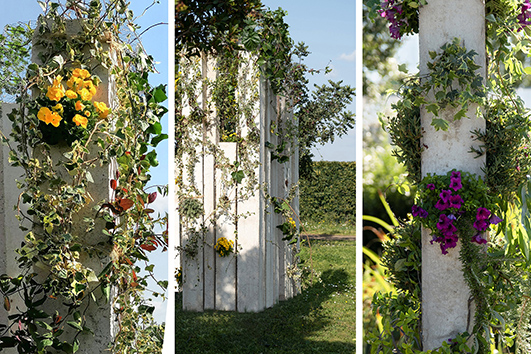Order, complexity, measure. The project between architecture and nature
DOI:
https://doi.org/10.19229/2464-9309/1192022Keywords:
architecture, innovative technologies, bio-design, biophilic design, nature and knowledgeAbstract
The paper aims to show how modern technologies, including those coming from established habits – today with great possibilities – have shifted towards new building horizons with an ‘ecological conscience’, avoiding uncritically referring to nature as a salvific model, to be imitated and evoked, perhaps with formal and superficial operations. The paper contains some varied project experiences. Even though the projects start from different premises, they develop experimental solutions identifying nature as a principle to elaborate by updating its rules. Among these, we find both a prototype of urban micro-design that incorporates vegetal processes and rules its aesthetic and functional benefits, where nature is integrated into the building technique, and projects with an indigenous origin important for the implementation of the symbiosis between nature and architecture in the built environment.
Downloads
Article Metrics Graph
References
Brook, C. (ed.) (2014) The City and The Spirit Garden – Prince Arthur’s Landing Thunder Bay, The City of Thunder Bay. [Online] Available at: issuu.com/brookmcilroy/docs/pal_draft9_edited_for_online_public [Accessed 14 April 2022].
Browning, W. D., Ryan, C. O. and Clancy, J. O. (2014), 14 Patterns of Biophilic Design – Improving Health & Well-Being in the Built Environment, Terrapin – Bright Green LLC, New York. [Online] Available at: terrapinbrightgreen.com/wp-content/uploads/2014/04/14-Patterns-of-Biophilic-Design-Terrapin-2014e.pdf [Accessed 14 April 2022].
CCAB – Canadian Council of Aboriginal Business (2019), Business Reconciliation in Canada – Guidebook. [Online] Available at: ccab.com/wp-content/uploads/2019/09/Business-reconciliation-in-canada_WEB-final_AA.pdf [Accessed 14 April 2022].
Crum, S. M., Shiflett, S. A. and Jenerette, G. D. (2017), “The influence of vegetation, mesoclimate and meteorology on urban atmospheric microclimates across a coastal to desert climate gradient”, in Journal of Environmental Management, vol. 200, pp. 295-303. [Online] Available doi.org/10.1016/j.jenvman.2017.05.077 [Accessed 14 April 2022].
ECC – Environment and Climate Change Canada (2020), A Healthy Environment and a Healthy Economy – Canada’s strengthened climate plan to create jobs and support people, communities and the planet. [Online] Available at: canada.ca/en/services/environment/weather/climatechange/climate-plan/climate-plan-overview/healthy-environment-healthy-economy.html [Accessed 14 April 2022].
Devidson, J. and Gorrie, R. (2021), “Indigenous Reclamation Through Landscape Design | L’Aménagement Paysager, outil de Reconquête Autochtone”, in Landscapes/Paysages, vol. 23, issue 4, pp. 40-43.
Dewey, J. (1949), Logica, teoria dell’indagine, Einaudi, Torino.
Gerfen, K. (2009), “Green Wall Systems – Phytoremediation Wall System”, in Architect Magazine, 11/09/2009. [Online] Available at: architectmagazine.com/awards/r-d-awards/green-wall-systems-active-phytoremediation-wall-system_o [Accessed 14 April 2022].
Granata, E. (2021), Placemaker – Gli inventori dei luoghi che abiteremo, Einaudi, Torino.
Heidegger, M. (1968), L’epoca dell’immagine del mondo in Sentieri interrotti, La Nuova Italia, Firenze.
Myers, W. (2018), Bio Design – Nature, science, creativity, Thames & Hudson Ltd, London.
Offenhuber, D. and Ratti, C. (eds) (2014), Decoding the City – Urbanism in the Age of Big Data, Birkhäuser, Basel. [Online] Available at: academia.edu/9468998/Decoding_the_City_Urbanism_in_the_ Age_of_Big_Data [Accessed 14 April 2022].
RAIC – Royal Architecture Institute of Canada (2020), Taking Action – A Conversation on Climate Action and Architecture in Canada– An RAIC 2021 Congress on Architecture Event, October 5, 2020 – Summary Report. [Online] Available at: docplayer.net/213321178-Congres-congress-on-architecture-a-conversation-on-climate-action-and-architecture-in-canada-sur-l-architecture-october-5-2020-taking-action.html [Accessed 14 April 2022].
Reed, G., Gobby, J., Sinclair, R., Ivey, R. and Matthews, H. D. (2021), “Indigenizing Climate Policy in Canada – A Critical Examination of the Pan-Canadian Framework and the ZéN RoadMap”, in Frontiers in Sustainable Cities, vol. 3, article 644675, pp. 1-12. [Online] Available at: doi.org/10.3389/frsc.2021.644675 [Accessed 14 April 2022].
Rilke, R. M. (1980), Lettera a un giovane poeta – Lettere a una giovane signora – Su Dio, Adelphi, Milano.
Robinson, A. (2018), “Turtle Island”, in The Canadian Encyclopedia, 06/11/2018. [Online] Available at: thecanadianencyclopedia.ca/en/article/turtle-island [Accessed 14 April 2022].
SGEI – Seven Generations Education Institute (2021), “Seven Grandfather Teachings”, in 7generations.org, 03/02/2021. [Online] Available at: 7generations.org/seven-grandfather-teachings/?fbclid=IwAR1Ecq2MBe9Wtq_j5Rz-qeRXW-i-ExC7iDRjKEgbxNQXjShWThOjyKl_-K4 [Accessed 14 April 2022].
Sichenze, A. (2011), Architettura vs Nichilismo, Mimesis, Milano.
UN – General Assembly (2015), Transforming our world – The 2030 Agenda for Sustainable Development, document A/RES/70/1. [Online] Available at: un.org/ga/search/view_doc.asp?symbol=A/RES/70/1&Lang=E [Accessed 10 November 2021].
Valle, L. (2011), Dall’ecologia all’ecosofia – Percorsi epistemici ed etici tra Oriente e Cristianesimo, tra scienza e saggezza, Ibis, Como-Pavia.
Watson, J. (2019), Lo-TEK – Design by Radical Indigenism, Taschen, Cologne.

Downloads
Published
How to Cite
Issue
Section
License
This Journal is published under Creative Commons Attribution Licence 4.0 (CC-BY).
License scheme | Legal code
This License allows anyone to:
Share: copy and redistribute the material in any medium or format.
Adapt: remix, transform, and build upon the material for any purpose, even commercially.
Under the following terms
Attribution: Users must give appropriate credit, provide a link to the license, and indicate if changes were made; users may do so in any reasonable manner, but not in any way that suggests the licensor endorses them or their use.
No additional restrictions: Users may not apply legal terms or technological measures that legally restrict others from doing anything the license permits.
Notices
Users do not have to comply with the license for elements of the material in the public domain or where your use is permitted by an applicable exception or limitation.
No warranties are given. The license may not give users all of the permissions necessary for their intended use. For example, other rights such as publicity, privacy, or moral rights may limit how you use the material.


















































































